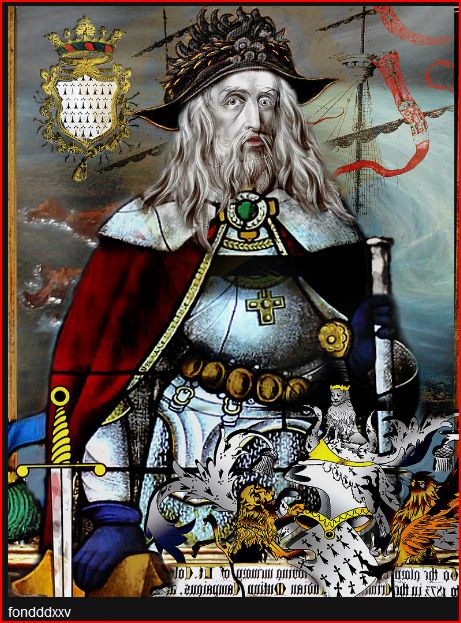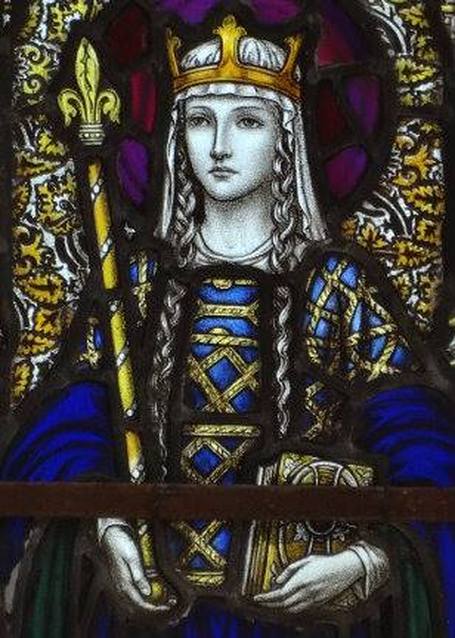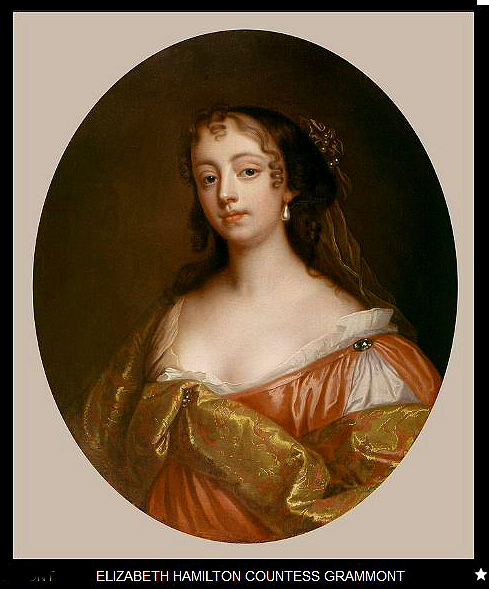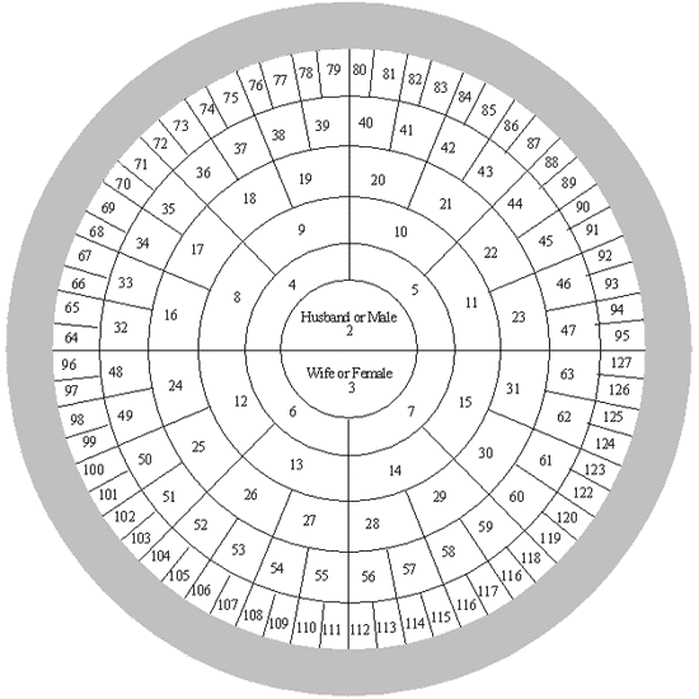Gateway Ancestors
It is good to be old in years for it often looks as if we were arriving at the end of the history of our world; or at least that it will get terribly dark before the light can shine again and make it possible to see clearly. ~ Carl Jung, Conversations with C.G. Jung, Page 67.
Once you have located what is known as a gateway ancestor, one who links your family to a known noble ancestry, the door opens upon a world of recorded and published pedigrees that can lead back to royalty. He may be a vicar or a tradesman perhaps; he will probably stand out against the background of more humble contemporaries.
What is a Gateway Ancestor? In tracing any extended ancestry beyond, say, one hundred years ago, we see ancestors clumping into groups, sharing a single geographic location (perhaps the Connecticut Valley, or the Casco Bay area) or a common economic or ethnic identity (say, working-class Irish immigrants in New York City, or wealthy merchant barons intermarried between Newport and Baltimore). Further back in time, as new ‘clumps’ of similar ancestors appear, each new clump is connected to the rest through a single ancestor whom we can call a ‘gateway’. So in broad terms, a gateway ancestor is any individual with known or traceable ancestry in a specific group who intermarries into a target group, and therefore adds a new set of ancestors to his or her descendants in the target group. For example, every immigrant from one country to another is a potential gateway, if his or her descendants can then trace ancestry in the first country. Gateways can also occur within a single geographic area, when someone moves from one distinct social group into another, across relatively distinct religious, economic or racial barriers.
In American genealogy this term is commonly used for immigrants — and usually colonial immigrants —who provide descendants in the New World with significant traceable ancestry in the Old World. In this case, while one may descend from many immigrants, only those whose ancestry is known and traceable can be considered gateways. More narrowly, though, the term in the Americas to distinguish immigrants with traceable lines to royal ancestry in England or Continental Europe. These are the gateway ancestors targeted in Gary Boyd Roberts’s justly popular compilation Royal Descents of 500 Immigrants to the Unites States (forthcoming in a much-revised version). For countless Americans, whether they know it or not, and countless others of European ancestry, these gateways provide a tangible personal link to the medieval world, in the form of descents from medieval kings, queens, popes, crusaders, troubadours, heroes, villains, and saints.
http://nltaylor.net/sketchbook/archives/11
What is a Gateway Ancestor? In tracing any extended ancestry beyond, say, one hundred years ago, we see ancestors clumping into groups, sharing a single geographic location (perhaps the Connecticut Valley, or the Casco Bay area) or a common economic or ethnic identity (say, working-class Irish immigrants in New York City, or wealthy merchant barons intermarried between Newport and Baltimore). Further back in time, as new ‘clumps’ of similar ancestors appear, each new clump is connected to the rest through a single ancestor whom we can call a ‘gateway’. So in broad terms, a gateway ancestor is any individual with known or traceable ancestry in a specific group who intermarries into a target group, and therefore adds a new set of ancestors to his or her descendants in the target group. For example, every immigrant from one country to another is a potential gateway, if his or her descendants can then trace ancestry in the first country. Gateways can also occur within a single geographic area, when someone moves from one distinct social group into another, across relatively distinct religious, economic or racial barriers.
In American genealogy this term is commonly used for immigrants — and usually colonial immigrants —who provide descendants in the New World with significant traceable ancestry in the Old World. In this case, while one may descend from many immigrants, only those whose ancestry is known and traceable can be considered gateways. More narrowly, though, the term in the Americas to distinguish immigrants with traceable lines to royal ancestry in England or Continental Europe. These are the gateway ancestors targeted in Gary Boyd Roberts’s justly popular compilation Royal Descents of 500 Immigrants to the Unites States (forthcoming in a much-revised version). For countless Americans, whether they know it or not, and countless others of European ancestry, these gateways provide a tangible personal link to the medieval world, in the form of descents from medieval kings, queens, popes, crusaders, troubadours, heroes, villains, and saints.
http://nltaylor.net/sketchbook/archives/11
Watkinson
Non-American gateways
Among early American colonists, ‘gateway ancestors’ can distinguish any immigrant of *known* ancestry from the vast majority whose English origins are unknown; or, further, any individual of traceable noble ancestry from those whose ancestries fizzle out with the creation of parish registers in the 16th century. For those with non-US ancestry, there will be other common gateways in the demographic history of their ancestral populations, such as colonial South American immigrants with the same characteristics as above (any traceable ancestry, or traceable noble ancestry), or early settlers in Australia, etc. Within the medieval period, the term is used for exogamous marriages where a spouse from a different social group brings in new ancestry (for example, the various Byzantine ‘gateways’ into Western royalty in the High Middle Ages, or the Burgundian gateways that bring Carolingian ancestry to the Iberian royals in the early 12th c., etc.). Simply put, the more ‘gateways’ of all types that one can find in one’s ancestry, the more diverse and multilayered will be one’s discernible tree.
Among early American colonists, ‘gateway ancestors’ can distinguish any immigrant of *known* ancestry from the vast majority whose English origins are unknown; or, further, any individual of traceable noble ancestry from those whose ancestries fizzle out with the creation of parish registers in the 16th century. For those with non-US ancestry, there will be other common gateways in the demographic history of their ancestral populations, such as colonial South American immigrants with the same characteristics as above (any traceable ancestry, or traceable noble ancestry), or early settlers in Australia, etc. Within the medieval period, the term is used for exogamous marriages where a spouse from a different social group brings in new ancestry (for example, the various Byzantine ‘gateways’ into Western royalty in the High Middle Ages, or the Burgundian gateways that bring Carolingian ancestry to the Iberian royals in the early 12th c., etc.). Simply put, the more ‘gateways’ of all types that one can find in one’s ancestry, the more diverse and multilayered will be one’s discernible tree.
What Is a Gateway Ancestor?
Most Americans with sizable New England Yankee, mid-Atlantic Quaker,
or Southern "planter" ancestry are descended from medieval
kings--kings of England, Scotland, and France especially.
Once you have located what is known as a gateway ancestor, one who links your family to a known noble ancestry, the door opens to a world of recorded and published pedigrees that can lead back to royalty.
Most Americans with sizable New England Yankee, mid-Atlantic Quaker,
or Southern "planter" ancestry are descended from medieval
kings--kings of England, Scotland, and France especially.
Once you have located what is known as a gateway ancestor, one who links your family to a known noble ancestry, the door opens to a world of recorded and published pedigrees that can lead back to royalty.
Saint Margaret of Scotland b 1045, wife to Malcolm III b1031
HISTORICAL FIGURES:
- Charlemagne Holy Roman Emperor
- Charlemagne- 25 Generations Descendant Chart Descendant Chart (work in progress)
- Charlemagne to Mérovée Ancestor Pedigree Chart
- Henry I, King of England Descendant Chart Descendant Chart
- Henry II, King of England Descendant Chart Descendant Chart
- Hildegarde of Swabia to Mérovée Ancestor Pedigree Chart
- John I, King of England-Magna Charta Descendant Chart Descendant Chart
- Mérovée (Merovech) Founder of the Merovingian Dynasty
- Mérovée (Merovech), governed the Salic Franks 448-457 Descendant Chart Descendant Chart
- Edward I, King of England Descendant Chart Descendant Chart
- Eleanor of Aquitaine Descendant Chart Descendant Chart
- William I, The Conqueror Descendant Chart Descendant Chart
Very simply, a “Gateway Ancestor” is your immigrant ancestor who has royal descent. He or she, then, is your American “gateway” to royalty. "Gateway Ancestors" are colonists or immigrants who came to America that are descended of royal blood.
Several useful resources exist to assist individuals in determining whether they have Gateway Ancestors. The “short list” includes:
Douglas Richardson, Magna Carta Ancestry: A Study in Colonial and Medieval Families (4 vols., newly revised and enlarged, 2011)
Magna Carta Ancestry celebrate the history of this important document and honor the twenty-five barons who witnessed this event, of whom only seventeen have descendants today. The seventeen barons with surviving descendants are (1) William d'Albini/d'Aubigny, (2) Roger Bigod, (3) Hugh Bigod, (4) Henry de Bohun, (5) Richard de Clare, (6) Gilbert de Clare, (7) John Fitzrobert, (8) Robert Fitzwalter, (9) William de Huntingfield, (10) John de Lacie/Lacy, (11)William de Lanvallei, (12) William Malet, (13) William de Mowbray, (14) Saire de Quincey, (15) Robert de Roos, (16) Geoffrey de Saye and (17) Robert de Vere.
Douglas Richardson, Plantagenet Ancestry: A Study in Colonial and Medieval Families (3 vols., newly revised and enlarged, 2011)
Gary Boyd Roberts, Royal Descents of 600 Immigrants to the American Colonies or the United States (2004 and 2008 editions)
Patricia Ann Scherzinger, Colonial Americans of Royal and Noble Descent: Alleged, Proven and Disproven
Frederick Lewis Weis, Ancestral Roots of Certain American Colonists Who Came to America before 1700 (7th and 8th editions)
Denis Beauregard's website Genealogy of the French in North America.
A number of illegitimate children of English royalty married well, led productive lives and left descendants to this day. The Society of Royal Bastard Ancestry traces the lineage of its members to these royal bastard offspring of King Henry I (Robert de Caen, Reynold de Dunstanville, Elizabeth of England, Henry fitz Henry, Robert fitz Edith, Reginald fitz Roy and Constance), his grandson Henry II (William Longespee) and his great-grandson John, who set his seal on the Magna Carta at Runnemede on 15 June 1215 (Richard fitz Roy).
Remember when using secondary or consolidated genealogical resources whether in print or on the Internet, that you are using Other People's Research (OPR). There is good OPR and bad OPR. Good OPR has footnotes that cite to primary sources such as probate records, patent rolls, inquisitions post mortems (IPMs), and contemporary medieval records. Good OPR always gives a reason for making a conclusion. Bad OPR is just wrong information that does not realize it is wrong.
Several useful resources exist to assist individuals in determining whether they have Gateway Ancestors. The “short list” includes:
Douglas Richardson, Magna Carta Ancestry: A Study in Colonial and Medieval Families (4 vols., newly revised and enlarged, 2011)
Magna Carta Ancestry celebrate the history of this important document and honor the twenty-five barons who witnessed this event, of whom only seventeen have descendants today. The seventeen barons with surviving descendants are (1) William d'Albini/d'Aubigny, (2) Roger Bigod, (3) Hugh Bigod, (4) Henry de Bohun, (5) Richard de Clare, (6) Gilbert de Clare, (7) John Fitzrobert, (8) Robert Fitzwalter, (9) William de Huntingfield, (10) John de Lacie/Lacy, (11)William de Lanvallei, (12) William Malet, (13) William de Mowbray, (14) Saire de Quincey, (15) Robert de Roos, (16) Geoffrey de Saye and (17) Robert de Vere.
Douglas Richardson, Plantagenet Ancestry: A Study in Colonial and Medieval Families (3 vols., newly revised and enlarged, 2011)
Gary Boyd Roberts, Royal Descents of 600 Immigrants to the American Colonies or the United States (2004 and 2008 editions)
Patricia Ann Scherzinger, Colonial Americans of Royal and Noble Descent: Alleged, Proven and Disproven
Frederick Lewis Weis, Ancestral Roots of Certain American Colonists Who Came to America before 1700 (7th and 8th editions)
Denis Beauregard's website Genealogy of the French in North America.
A number of illegitimate children of English royalty married well, led productive lives and left descendants to this day. The Society of Royal Bastard Ancestry traces the lineage of its members to these royal bastard offspring of King Henry I (Robert de Caen, Reynold de Dunstanville, Elizabeth of England, Henry fitz Henry, Robert fitz Edith, Reginald fitz Roy and Constance), his grandson Henry II (William Longespee) and his great-grandson John, who set his seal on the Magna Carta at Runnemede on 15 June 1215 (Richard fitz Roy).
Remember when using secondary or consolidated genealogical resources whether in print or on the Internet, that you are using Other People's Research (OPR). There is good OPR and bad OPR. Good OPR has footnotes that cite to primary sources such as probate records, patent rolls, inquisitions post mortems (IPMs), and contemporary medieval records. Good OPR always gives a reason for making a conclusion. Bad OPR is just wrong information that does not realize it is wrong.
Genealogy Wheel
The Wheel of Time
The Wheel of Time
A gateway ancestor is an ancestor who gives descendants a traceable path back to a new ancestral population—most commonly, in US usage, an early colonial immigrant providing traceable ancestry among medieval nobility and royalty.
For many years 'climbing the Mt. Everest of genealogy' meant to prove your ascent to Charlemagne, who was crowned the Emperor of western and central Europe in 800 A.D. That was the ultimate prize. While some mathematicians claim that virtually everyone of European descent is descended from Charlemagne, and others estimate that 50 to 80 percent of Westerners descend from Charlemagne, only about 2500 people have actually proven it.
In the US, first of all, you have to do all the usual genealogical research interviewing living relatives, securing solid proofs of links and dates, using DAR and other applications from your relatives (but checking them!), and working back gradually to the colonial era. Your target is at least one gateway ancestor -- a person whose ancestral line is already established back to European nobility or royalty.
The Crown of Charlemagne society lists 86 of these on its website www.charlemagne.org and has about 160 in
Once you have located what is known as a gateway ancestor, one who links your family to a known noble ancestry, the door opens upon a world of recorded and published pedigrees that can lead back to royalty.
Only 86 to 600 gateway ancestors may sound like a small target to shoot for. But remember, your chances are mathematically better than you think. By going back to the 1650 or so, you are exploring 12 generations (12 x 30 years per generation = 360 years). Barring intermarriage of cousins, there would be 4096 (2 to the 12th power) ancestors in your 12th generation, and there were only a few thousand Western people on the eastern shores of America in 1650. So the chances that one of yours is a gateway ancestor are pretty good. Keep looking!
Next, you should review the line from your gateway ancestor up to Charlemagne. Most of these ascents go through the English or French kings, such as Henry II of England and Eleanor of Aquitaine.
As new ‘clumps’ of similar ancestors appear, each new clump is connected to the rest through a single ancestor whom we can call a ‘gateway’. So in broad terms, a gateway ancestor is any individual with known or traceable ancestry in a specific group who intermarries into a target group, and therefore adds a new set of ancestors to his or her descendants in the target group. For example, every immigrant from one country to another is a potential gateway, if his or her descendants can then trace ancestry in the first country. Gateways can also occur within a single geographic area, when someone moves from one distinct social group into another, across relatively distinct religious, economic or racial barriers.
In American genealogy this term is commonly used for immigrants — and usually colonial immigrants —who provide descendants in the New World with significant traceable ancestry in the Old World. In this case, while one may descend from many immigrants, only those whose ancestry is known and traceable can be considered gateways.
As some 25,000 (mainly) English came to New England c.1620-1640, each might be considered a "gateway". If one means gateways-with-ancient-royal ancestry" that's another matter altogether. They would number in 17th century British America perhaps up to 200 or so *proved* lines. More narrowly, though, the gateway term in the Americas distinguishes immigrants with traceable lines to royal ancestry in England or Continental Europe.
These are the gateway ancestors targeted in Gary Boyd Roberts’s compilation Royal Descents of 500 Immigrants to the Unites States. For countless Americans, whether they know it or not, and countless others of European ancestry, these gateways provide a tangible personal link to the medieval world, in the form of descents from medieval kings, queens, popes, crusaders, troubadours, heroes, villains, and saints. Sooner or later, a gateway is likely to turn up in any sufficiently "bushy" New England family tree.
The relative importance of a gateway ancestor, for research purposes, depends on (1) the amount of new and traceable ancestry a gateway brings into the target population, and (2) the number of descendants that gateway has, which insures a large interest base. Based on these two factors, early immigrants with traceable royal ancestry are the most talked about gateways, but not really out of any class-oriented prejudice. Among early immigrants from Europe to the Americas, individuals with noble connections are likely to be traceable to a vastly larger number of ancestors, and thus sustain more interest and offer more connections as ‘gateways’.
In contrast, others whose parentage might be known, may still only provide three generations of ancestry, perhaps back to the beginnings of the parish registers and no further: obviously, gentry connections are a ‘gateway’ which is quantitatively superior (for ancestor collectors) as well as offering greater likelihood that someone may be able to learn about specific members of that tree. Thus the prejudicial desire for such ancestors should not be equated simply with elitism.
Within the medieval period, the term is used for exogamous marriages where a spouse from a different social group brings in new ancestry (for example, the various Byzantine ‘gateways’ into Western royalty in the High Middle Ages, or the Burgundian gateways that bring Carolingian ancestry to the Iberian royals in the early 12th c., etc.). Simply put, the more ‘gateways’ of all types that one can find in one’s ancestry, the more diverse and multilayered will be one’s discernible tree. http://nltaylor.net/sketchbook/archives/11
Is that the end of your climbing quest? Yes and no. Many people are content with pushing back their family tree to the year 800. Very impressive. But a few years ago some medieval specialists began researching the ancestors of Charlemagne. These reputable genealogists found convincing proofs from Charlemagne back to Merovee, King of the Salic Franks, who lived from about 415 to 458 A.D., and who ruled much of present day France and the low countries.
Based on this discovery, the Order of the Merovingian Dynasty was formed (see http://merovingiandynasty.com/), and anyone who has proven their ascent to Charlemagne can join.
Still not content, with 45 generations and almost 1600 years of proven lineage? Want to climb higher still? There is now another Mt. Everest to ascend, even earlier than King Merovee. This is possible through the newly formed National Society of Saints and Sinners (www.nationalsocietyofsaintsandsinners.org/).
This society draws on the excellent book by Alan J. Koman, A Who's Who of Your Ancestral Saints, supplemented by extensive research by the well-known genealogist Alex Bannerman. This society provides information on 275 early and medieval saints who are ancestors of famous persons in the Middle Ages.
Queen St. Margaret of Scotland
King St. Alfred the Great of England
St. Begga of Landen
St. Gregory “the Illuminator,” Bishop of Leontius
King St. Edgar “the Peaceful” of England
St. Clothilde of Burgundy
You may ask, “How do I descend from one of these saints?” Here is a brief (though certainly not all-inclusive) “kinexions” list for assistance:
If you descend from any one of the Plantagenet kings of England (Edward III backward to Henry II), you are a descendant of Queen St. Margaret of Scotland. There are, of course, other routes. You also descend if you intersect at earlier points, completely missing the Plantagenet kings, such as through Matilda, wife of Geoffrey V Plantagenet, or King David of Scotland (himself a saint).
If you descend from any of the people in the previous paragraph, you also descend from King St. Alfred the Great of England and King St. Edgar “the Peaceful” of England.
The Emperor Charlemagne is a direct descendant of St. Begga of Landen and St. Clothilde of Burgundy, so it is quite easy to get back to either of these very interesting women from history.
Finally, St. Gregory “the Illuminator,” Bishop of Leontius, is an interesting personage if for no other reason than the period in which he lived: c257-c331. If you descend from Eleanor of Castile, first wife of King Edward I of England, for instance, you are able to take your ancestry backward to a saint who lived nearly two millennia ago!
ref. http://nationalsocietyofsaintsandsinners.org/membership/
For many years 'climbing the Mt. Everest of genealogy' meant to prove your ascent to Charlemagne, who was crowned the Emperor of western and central Europe in 800 A.D. That was the ultimate prize. While some mathematicians claim that virtually everyone of European descent is descended from Charlemagne, and others estimate that 50 to 80 percent of Westerners descend from Charlemagne, only about 2500 people have actually proven it.
In the US, first of all, you have to do all the usual genealogical research interviewing living relatives, securing solid proofs of links and dates, using DAR and other applications from your relatives (but checking them!), and working back gradually to the colonial era. Your target is at least one gateway ancestor -- a person whose ancestral line is already established back to European nobility or royalty.
The Crown of Charlemagne society lists 86 of these on its website www.charlemagne.org and has about 160 in
- Tracy Crocker, Order of the Crown of Charlemagne: Verified Lineages...
- Boyd Roberts, Royal Descents of 600 Immigrants
- Patricia Scherzinger, Colonial Americans of Royal and Noble Descent.
- Some gateway ancestors are famous, but many are ordinary early immigrants.
Once you have located what is known as a gateway ancestor, one who links your family to a known noble ancestry, the door opens upon a world of recorded and published pedigrees that can lead back to royalty.
Only 86 to 600 gateway ancestors may sound like a small target to shoot for. But remember, your chances are mathematically better than you think. By going back to the 1650 or so, you are exploring 12 generations (12 x 30 years per generation = 360 years). Barring intermarriage of cousins, there would be 4096 (2 to the 12th power) ancestors in your 12th generation, and there were only a few thousand Western people on the eastern shores of America in 1650. So the chances that one of yours is a gateway ancestor are pretty good. Keep looking!
Next, you should review the line from your gateway ancestor up to Charlemagne. Most of these ascents go through the English or French kings, such as Henry II of England and Eleanor of Aquitaine.
As new ‘clumps’ of similar ancestors appear, each new clump is connected to the rest through a single ancestor whom we can call a ‘gateway’. So in broad terms, a gateway ancestor is any individual with known or traceable ancestry in a specific group who intermarries into a target group, and therefore adds a new set of ancestors to his or her descendants in the target group. For example, every immigrant from one country to another is a potential gateway, if his or her descendants can then trace ancestry in the first country. Gateways can also occur within a single geographic area, when someone moves from one distinct social group into another, across relatively distinct religious, economic or racial barriers.
In American genealogy this term is commonly used for immigrants — and usually colonial immigrants —who provide descendants in the New World with significant traceable ancestry in the Old World. In this case, while one may descend from many immigrants, only those whose ancestry is known and traceable can be considered gateways.
As some 25,000 (mainly) English came to New England c.1620-1640, each might be considered a "gateway". If one means gateways-with-ancient-royal ancestry" that's another matter altogether. They would number in 17th century British America perhaps up to 200 or so *proved* lines. More narrowly, though, the gateway term in the Americas distinguishes immigrants with traceable lines to royal ancestry in England or Continental Europe.
These are the gateway ancestors targeted in Gary Boyd Roberts’s compilation Royal Descents of 500 Immigrants to the Unites States. For countless Americans, whether they know it or not, and countless others of European ancestry, these gateways provide a tangible personal link to the medieval world, in the form of descents from medieval kings, queens, popes, crusaders, troubadours, heroes, villains, and saints. Sooner or later, a gateway is likely to turn up in any sufficiently "bushy" New England family tree.
The relative importance of a gateway ancestor, for research purposes, depends on (1) the amount of new and traceable ancestry a gateway brings into the target population, and (2) the number of descendants that gateway has, which insures a large interest base. Based on these two factors, early immigrants with traceable royal ancestry are the most talked about gateways, but not really out of any class-oriented prejudice. Among early immigrants from Europe to the Americas, individuals with noble connections are likely to be traceable to a vastly larger number of ancestors, and thus sustain more interest and offer more connections as ‘gateways’.
In contrast, others whose parentage might be known, may still only provide three generations of ancestry, perhaps back to the beginnings of the parish registers and no further: obviously, gentry connections are a ‘gateway’ which is quantitatively superior (for ancestor collectors) as well as offering greater likelihood that someone may be able to learn about specific members of that tree. Thus the prejudicial desire for such ancestors should not be equated simply with elitism.
Within the medieval period, the term is used for exogamous marriages where a spouse from a different social group brings in new ancestry (for example, the various Byzantine ‘gateways’ into Western royalty in the High Middle Ages, or the Burgundian gateways that bring Carolingian ancestry to the Iberian royals in the early 12th c., etc.). Simply put, the more ‘gateways’ of all types that one can find in one’s ancestry, the more diverse and multilayered will be one’s discernible tree. http://nltaylor.net/sketchbook/archives/11
Is that the end of your climbing quest? Yes and no. Many people are content with pushing back their family tree to the year 800. Very impressive. But a few years ago some medieval specialists began researching the ancestors of Charlemagne. These reputable genealogists found convincing proofs from Charlemagne back to Merovee, King of the Salic Franks, who lived from about 415 to 458 A.D., and who ruled much of present day France and the low countries.
Based on this discovery, the Order of the Merovingian Dynasty was formed (see http://merovingiandynasty.com/), and anyone who has proven their ascent to Charlemagne can join.
Still not content, with 45 generations and almost 1600 years of proven lineage? Want to climb higher still? There is now another Mt. Everest to ascend, even earlier than King Merovee. This is possible through the newly formed National Society of Saints and Sinners (www.nationalsocietyofsaintsandsinners.org/).
This society draws on the excellent book by Alan J. Koman, A Who's Who of Your Ancestral Saints, supplemented by extensive research by the well-known genealogist Alex Bannerman. This society provides information on 275 early and medieval saints who are ancestors of famous persons in the Middle Ages.
Queen St. Margaret of Scotland
King St. Alfred the Great of England
St. Begga of Landen
St. Gregory “the Illuminator,” Bishop of Leontius
King St. Edgar “the Peaceful” of England
St. Clothilde of Burgundy
You may ask, “How do I descend from one of these saints?” Here is a brief (though certainly not all-inclusive) “kinexions” list for assistance:
If you descend from any one of the Plantagenet kings of England (Edward III backward to Henry II), you are a descendant of Queen St. Margaret of Scotland. There are, of course, other routes. You also descend if you intersect at earlier points, completely missing the Plantagenet kings, such as through Matilda, wife of Geoffrey V Plantagenet, or King David of Scotland (himself a saint).
If you descend from any of the people in the previous paragraph, you also descend from King St. Alfred the Great of England and King St. Edgar “the Peaceful” of England.
The Emperor Charlemagne is a direct descendant of St. Begga of Landen and St. Clothilde of Burgundy, so it is quite easy to get back to either of these very interesting women from history.
Finally, St. Gregory “the Illuminator,” Bishop of Leontius, is an interesting personage if for no other reason than the period in which he lived: c257-c331. If you descend from Eleanor of Castile, first wife of King Edward I of England, for instance, you are able to take your ancestry backward to a saint who lived nearly two millennia ago!
ref. http://nationalsocietyofsaintsandsinners.org/membership/
11 Generation Circle Chart
A true 11 Generation Circle Chart. An amazing chart which allows entry for a massive 1535 Ancestors.
A true 11 Generation Circle Chart. An amazing chart which allows entry for a massive 1535 Ancestors.
Lady Margaret SHELTON Born: AFT 1500
(c)2013; All Rights Reserved, Iona Miller, Sangreality Trust
[email protected]
Fair Use Notice
This site contains copyrighted material the use of which has not always been specifically authorized by the copyright owner. We are making such material available in our efforts to advance understanding of environmental, political, human rights, economic, democracy, scientific, and social justice issues, etc. We believe this constitutes a 'fair use' of any such copyrighted material as provided for in section 107 of the US Copyright Law. In accordance with Title 17 U.S.C. Section 107, the material on this site is distributed without profit to those who have expressed a prior interest in receiving the included information for research and educational purposes. If you wish to use copyrighted material from this site for purposes of your own that go beyond 'fair use', you must obtain permission from the copyright owner.
[email protected]
Fair Use Notice
This site contains copyrighted material the use of which has not always been specifically authorized by the copyright owner. We are making such material available in our efforts to advance understanding of environmental, political, human rights, economic, democracy, scientific, and social justice issues, etc. We believe this constitutes a 'fair use' of any such copyrighted material as provided for in section 107 of the US Copyright Law. In accordance with Title 17 U.S.C. Section 107, the material on this site is distributed without profit to those who have expressed a prior interest in receiving the included information for research and educational purposes. If you wish to use copyrighted material from this site for purposes of your own that go beyond 'fair use', you must obtain permission from the copyright owner.











